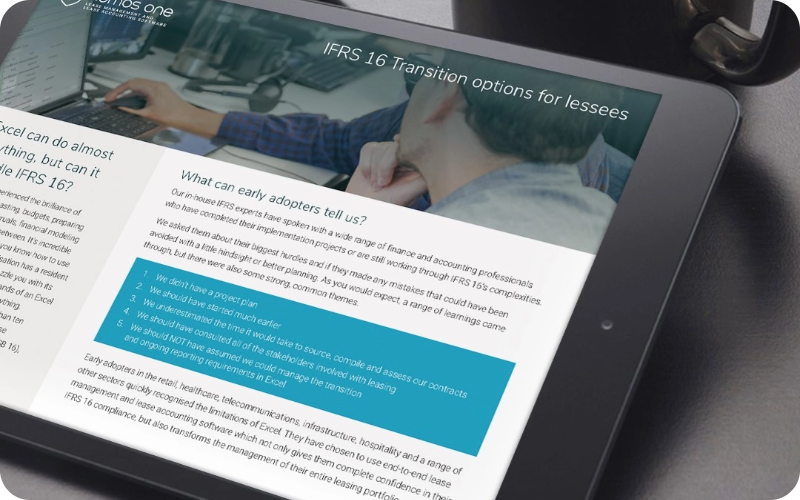Optimising your vehicle lease management is a game-changer. Whether you run a small delivery service or oversee a transportation company with a sprawling fleet of cars, effective lease management can lead to significant cost savings and operational improvements.
In this article, we explore the essentials of vehicle lease management: streamlining your operations for maximum efficiency and navigating the complex terrain of IFRS 16 lease accounting. Whether you're a seasoned fleet manager or just diving into this crucial aspect of your business, read on to unlock the insights and strategies that will help you make the most out of your fleet.
Understanding vehicle lease management
Vehicle lease management involves the oversight of all aspects related to your leased vehicles, from procurement to maintenance and eventual disposition. For businesses that rely on a fleet of vehicles, it's a critical function that can impact the bottom line. Before we discuss this in detail, it is important to mention the following aspects included in effective lease management:

Know your fleet inside out
Your fleet isn't just a collection of vehicles; it's a vital part of your business operations. Start by conducting a comprehensive assessment of your lease portfolio. Understand the terms, conditions, and costs associated with each vehicle lease. This information forms the foundation of effective lease management.
Regular maintenance and monitoring
Just as you wouldn't skip regular vehicle maintenance, don't neglect your lease agreements. Regularly monitor lease terms, maintenance schedules, and renewal options. Staying on top of these details prevents unexpected expenses and disruptions in your operations.
Cost control strategies
Effective cost management is the backbone of successful fleet management. Look for opportunities to optimise costs by renegotiating lease terms, consolidating leases, or exploring more fuel-efficient vehicle options. Every dollar saved here goes straight to your bottom line.
Fleet management: Essential steps
Here are five essential steps constituting effective vehicle fleet management:
Procurement and selection
The process begins with selecting the right vehicles for your fleet. Consider factors like fuel efficiency, maintenance costs, and the specific needs of your operations. Negotiating favourable lease terms is also key.
Maintenance and repairs
Regular maintenance is essential to keep your vehicles in top condition. Create a maintenance schedule, track repairs, and ensure that leased vehicles meet safety and compliance standards.
Mileage tracking
Accurate mileage tracking is important for both lease accounting and maintenance purposes. It helps you avoid excess mileage fees and ensures that vehicles are serviced at the appropriate intervals.
Lease renewals and returns
As leases approach their end date, evaluate whether to renew or return the vehicles. Timely decisions can help you avoid penalties and secure the best terms for the next lease.
Disposition
When it's time to return a leased vehicle, ensure it meets all return conditions. Address any wear and tear and consider whether purchasing the vehicle at the end of the lease is a cost-effective option.

Navigating vehicle lease accounting
Effective vehicle lease management goes hand-in-hand with lease accounting, especially in light of accounting standards like IFRS 16 (AASB 16). These standards require most leases, including vehicle leases, to be recognised on the balance sheet, which affects key financial metrics. As a result, understanding lease accounting standards and their implications helps to achieve accurate financial reporting and reduces the risk of non-compliance. Here's how to navigate lease accounting for your vehicle fleet:
Identify lease agreements
Start by identifying all lease agreements within your fleet, no matter how informal they may seem. At the inception of a contract, you will need to assess whether it is, or contains a lease.
Calculate present value
If your contract is assessed to be a lease, calculate the present value of lease payments to determine the right-of-use asset and lease liability to be reported on your balance sheet.
Depreciation and interest
To make sure your financial reporting is accurate, recognise depreciation and interest expenses over the lease term, and separately from other expenses.
Disclosure and documentation
Properly document lease agreement information and make disclosures in accordance with accounting standards. Maintaining supporting documentation is essential for audits and financial transparency.

Achieving efficiency and compliance
Compliance is vital to providing accurate financial statements and meeting regulatory requirements, while optimising processes and achieving operational efficiency can help your company reduce costs and save time. Here are a few steps to take in order to simplify compliance and increase productivity:
Centralised lease repository
Maintain a centralised digital repository for all lease-related documents. This ensures easy access to lease agreements, amendments, and schedules. No more digging through stacks of paperwork when you need critical lease information.
Lease compliance protocols
Develop and implement robust lease compliance protocols. These should cover everything from lease initiation to termination, ensuring that your lease agreements align with regulations and accounting standards.
Regular audits and reviews
Regularly audit your lease portfolio to identify areas for improvement. Consider engaging external experts to perform lease audits, helping you uncover hidden opportunities for cost savings.
Lease tracking software solutions
Embracing technology is the best way to simplify vehicle lease management. Consider implementing specialised lease tracking software, such as Nomos One, that can automate complex calculations, track lease modifications, streamline reporting and help achieve compliance with accounting standards, such as IFRS 16 (AASB 16). It's a wise investment that saves time, minimises errors and increases efficiency. By proactively managing leases, optimising vehicle selection, and staying compliant with accounting standards, you can significantly improve your fleet operations and drive success for your business.

























